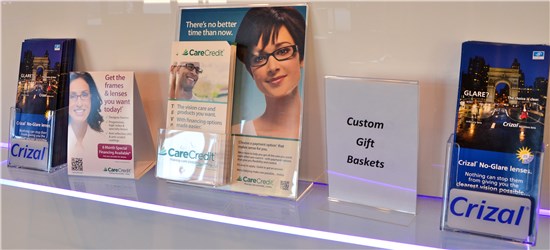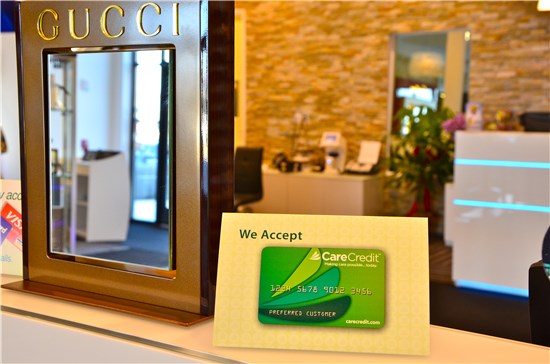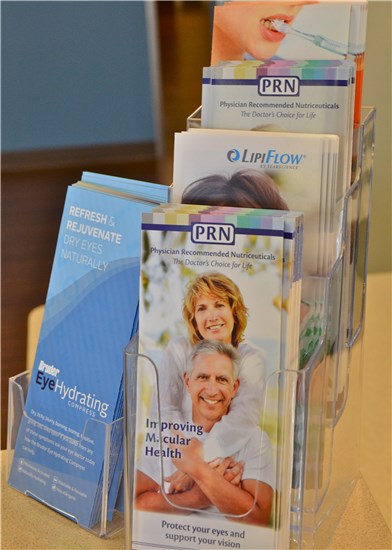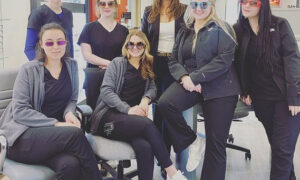
April 13, 2016
Point-of-sale materials are a great help when selling children’s eyewear, findings from Jobson Optical Research’s 2015 Selling Eyewear to Children report suggest. Thirty-one percent of independent eyecare professionals responding to the survey cited POP as “most helpful” when selling children’s eyewear. Some 27.3 percent said promotions were most helpful, and 12.1 percent cited special premiums as most helpful. Some 8.1 percent cited “vendor partnering on trunk shows, ad promotions, and/or in-school participation/demos as most helpful, while 5.7 percent cited giveaways, and 15.8 percent cited “other.”
 InvestorWords defines “point-of-sale (POS) materials” as “… display material to advertise a product where it is being sold …” POS material can be placed anywhere in the practice in an effort to draw patients’ attention to specific services and materials. POS materials occur in many forms. “POS displays can include shelf edging, dummy packs, display stands, mobiles, posters, and banners.” Think bigger. Your frame boards can also be considered as POS materials.
InvestorWords defines “point-of-sale (POS) materials” as “… display material to advertise a product where it is being sold …” POS material can be placed anywhere in the practice in an effort to draw patients’ attention to specific services and materials. POS materials occur in many forms. “POS displays can include shelf edging, dummy packs, display stands, mobiles, posters, and banners.” Think bigger. Your frame boards can also be considered as POS materials.
There are three issues about POS materials for us to consider today: design, clutter, and return on investment (ROI).
Design
It is much easier to have a treatment plan discussion with a patient who is asking you for services and materials than trying to convince them they need services or materials. Design is the essential component that is most often missing. Design helps guide patients in the conversation as they move through the practice so that by the time they get to the exam room they have been prepared for a discussion about services and materials they need.
 Moments of Truth marketing teaches us that every place a patient stops as they move through a practice is a place for us to put marketing messages that move patients toward specific actions. Don’t wait until the patient gets to the exam room or optical to begin a conversation with them about a product or service. Instead, start the conversation at the reception desk with POS material. Continue the conversation in the reception area with more POS material. Further the discussion at the pre-test location. Each of these steps prepares the patient for the exam room experience.
Moments of Truth marketing teaches us that every place a patient stops as they move through a practice is a place for us to put marketing messages that move patients toward specific actions. Don’t wait until the patient gets to the exam room or optical to begin a conversation with them about a product or service. Instead, start the conversation at the reception desk with POS material. Continue the conversation in the reception area with more POS material. Further the discussion at the pre-test location. Each of these steps prepares the patient for the exam room experience.
Start your design with the end in mind. What are the three most important actions you want patients to take as they leave the exam room? Once you answer that question, then design your internal marketing campaign using POS materials from beginning to end to help pre-set your patients to take those 3 actions.
 Clutter
Clutter
Keeping a practice clutter free requires effort. Every vendor coming into the practice wants to leave POS materials highlighting the newest and greatest advancements our world has ever seen. (Note to self: Don’t always believe messages that come to you on glossy paper).
A very powerful marketing rule is to say more with less. Our natural tendency is to over-explain. Even in the exam room we tend to use too many words. We also tend to use words when a picture is more powerful. Words are powerful, but use them sparingly in your internal marketing messages.
The normal response for analytical people when asked to identify the three most important actions under the DESIGN section above, is come up with 15-30 actions that are all equally important. When you clutter your message with too much information, then you risk diluting your message. When people are overwhelmed with information, they tend to make no decision rather than the decision we wanted them to make. Keep your pictures impactful and use your words sparingly.
ROI

ROI is simply a measurement of effectiveness. Once you have identified your three most important actions and created an internal marketing plan using POS materials that pre-sets the patient before getting to the exam room, now measure the effectiveness over the next three months. You should see more of the actions you are trying to promote occur in your practice.
If one of your actions was to pre-set patients that polarized sunwear is essential for safer daytime driving, the ROI question is: are you selling more polarized sunwear? This is an easy measurement to take. If it is working, then you have the right formula in place. If it is not working, then you need to change something. (Remember than Einstein said that doing the same thing over and over while expecting a different result is insanity).
ACTION PLAN
Your action plan for this week has three steps – and steps is what you will be taking as you walk through your practice.
CREATE MARKETING PLAN. Make sure you have a well-designed internal marketing plan for three actions you want patients to take as they leave your exam room. Walk through your practice making sure these messages are clear, powerful, and presented in different ways with different media as the patient moves from the reception desk through the practice.
ELIMINATE CLUTTER. Walk through your practice looking for clutter. Eliminate clutter. As much as possible, make sure your internal marketing messages are presented with the same branding. 20 different looks from 20 different manufactures’ POS materials looks cluttered. Have the POS material redone to match your branding if necessary.
Measure ROI. Make changes to the placement or to the marketing messages to improve ROI.
References
InvestorWords
InvestorWords Point-of-Sale Material
Wikipedia: Point-of-Sale Display

























